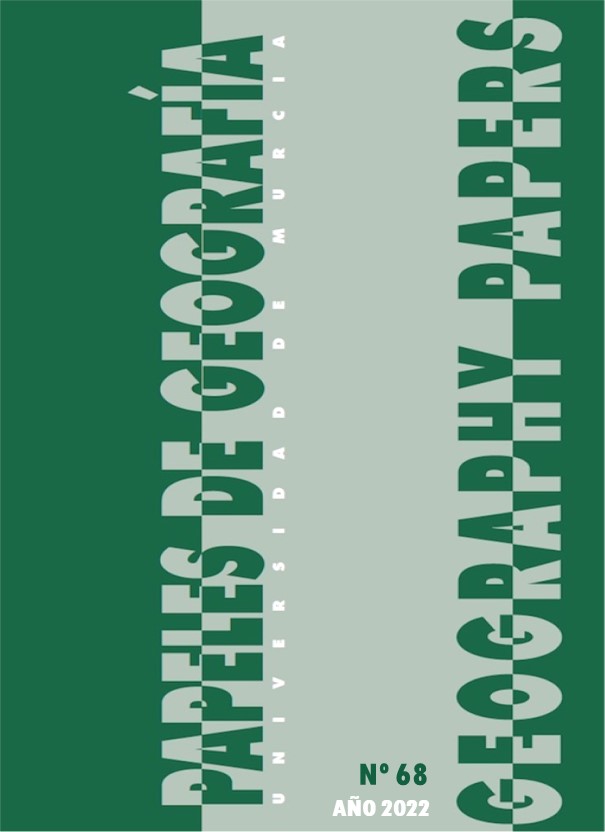EVALUACIÓN DEL REANALYSIS (NCEP/NCAR) PARA EL ESTUDIO DE LA VARIABILIDAD TERMO-PLUVIOMÉTRICA DEL NOROESTE ARGENTINO
Agencias de apoyo
- CONICET
- UNS
Resumen
El objetivo de esta investigación fue evaluar la precisión del modelo numérico Reanalysis NCEP/NCAR para la caracterización de la variabilidad termo-pluviométrica del Noroeste Argentino. Series meteorológicas in situ y modeladas del período 1960-2020 fueron estudiadas con técnicas estadísticas estándar. La variación espacial de la temperatura y la precipitación fue calculada con el método de interpolación Kriging. Un análisis de regresión cuantílica se aplicó a las series de tiempo. Para ello, las series fueron divididas en diez cuantiles y se evaluaron sus ajustes. Los resultados para ambas variables presentaron ajustes estadísticos significativos (p < 0,05), indicando que los datos del modelo Reanálisis permiten caracterizar la distribución espacial de estas variables. La temperatura del aire registró mejores resultados que la precipitación. Sin embargo, al estudiar los eventos extremos, se observaron diferencias importantes. La temperatura mostró buenos ajustes en los climas templados, seguidos por los climas áridos. La precipitación mostró ajustes significativos en los cuantiles medios, pero no así en los cuantiles extremos. Los resultados demostraron que el Reanalysis permite estudiar las características climáticas de la región NOA, pero no sus eventos extremos térmicos y pluviométricos. Además, esta base de datos es esencial para el estudio del clima a escala regional y para el diseño de planes de ordenamiento del territorio.
Descargas
-
Resumen390
-
PDF408
Citas
ALIAGA, V.S., FERRELLI, F., y PICCOLO, M.C. (2017): “Regionalization of climate over the Argentine Pampas”. International journal of climatology, vol. 37, p.1237-1247.
ARAYA-OSSES, D., CASANUEVA, A., ROMAN-FIGUEROA, C., URIBE, J.M., y PANEQUE, M. (2020): “Climate change projections of temperature and precipitation in Chile based on statistical downscaling”. Climate Dynamics, vol. 54, n° 9, p.4309-4330.
BECK, H.E., ZIMMERMANN, N.E., MCVICAR, T.R., VERGOPOLAN, N., BERG, A., y WOOD, E.F. (2018): “Present and future Köppen-Geiger climate classification maps at 1-km resolution”. Scientific data, vol.5, p.180214.
BUSTOS, M.L., FERRELLI, F., y PICCOLO, M.C. (2017): “Estudio Comparativo de Tres Modelos Climáticos en Argentina”. Anuário do Instituto de Geociências, vol. 40, n°1, p.34-43.
CANNON, A.J., SOBIE, S.R., y MURDOCK, T.Q. (2015): “Bias correction of GCM precipitation by quantile mapping: How well do methods preserve changes in quantiles and extremes?” Journal of Climate, vol. 28, n°17, p.6938-6959.
COLLAZO, S., BARRUCAND, M., y RUSTICUCCI, M. (2019): “Summer seasonal predictability of warm days in Argentina: statistical model approach”. Theoretical and Applied Climatology, vol. 138 n°3-4, p.1853-1876.
DA ROCHA REPINALDO, C.R., MÜLLER, G.V., y MARTINS ANDRADE, K. (2017): “Patrones Atmosféricos Simulados en el clima presente y futuro asociados al Descenso de temperatura en el invierno en el sudeste de Sudamérica”. Boletín geográfico, vol.39, p.13-34.
DEVERS, A., VIDAL, J. P., LAUVERNET, C., GRAFF, B., y VANNIER, O. (2020): “A framework for high‐resolution meteorological surface reanalysis through offline data assimilation in an ensemble of downscaled reconstructions”. Quarterly Journal of the Royal Meteorological Society, vol.146, n°726, p.153-173.
EUM, H.I., y CANNON, A.J. (2017): “Intercomparison of projected changes in climate extremes for South Korea: application of trend preserving statistical downscaling methods to the CMIP5 ensemble”. International Journal of Climatology, vol.37, n°8, p. 3381-3397.
FERRELLI, F., BUSTOS, M.L., PICCOLO, M.C., HUAMANTINCO CISNEROS, M.A. y PERILLO, G.M.E. (2016): “Downscaling de variables climáticas a partir del reanálisis NCEP/NCAR en el sudoeste de la provincia de Buenos Aires (Argentina)”. Papeles de Geografía, vol.62, p.21-33.
FERRELLI, F., BRENDEL, A., ALIAGA, V.S., PICCOLO, M.C., y PERILLO, G.M.E. (2019): “Climate regionalization and trends based on daily temperature and precipitation extremes in the south of the Pampas (Argentina)”. Cuadernos de Investigación Geográfica, vol. 45, n°1, p. 393-416.
FERRELLI, F. BUSTOS, M.L., PERILLO, G.M.E. y PICOLLO, M.C. (2021): “Evaluación de variables meteorológicas obtenidas del Reanalysis (NCEP/NCAR) para el estudio del clima de ciudades costeras de Argentina”. Investigaciones Geográficas, vol.76, p.263-284.
HEO, J.H., AHN, H., SHIN, J.Y., KJELDSEN, T.R., y JEONG, C. (2019): “Probability distributions for a quantile mapping technique for a bias correction of precipitation data: A case study to precipitation data under climate change”. Water, vol.11, n°7, p.1475.
HWANG, S., y GRAHAM, W.D. (2013): “Development and comparative evaluation of a stochastic analog method to downscale daily GCM precipitation”. Hydrology and Earth System Sciences, vol. 17, n°11, p.4481-4502.
INTERGOVERNMENTAL PANEL ON CLIMATE CHANGE (IPCC) (2013): “Climate change 2013: The physical science basis”. En: T.F. Stocker, D. Qin, G.-K. Plattner, M. Tignor, S.K. Allen, J. Boschung, A. Nauels, Y. Xia, V. Bex, P.M. Midgley (Eds.), Contribution of Working Group I to the Fifth Assessment Report of the Intergovernmental Panel on Climate Change (1535 p). Cambridge University Press: Cambridge, UK, y New York, USA.
INTERGOVERNMENTAL PANEL ON CLIMATE CHANGE (IPCC) (2021): “Climate Change 2021: The Physical Science Basis.Contribution of Working Group I to the Sixth Assessment Report of the Intergovernmental Panel on Climate Change”. Cambridge University Press. En prensa.
JEON, S., PACIOREK, C.J., & WEHNER, M.F. (2016): “Quantile-based bias correction and uncertainty quantification of extreme event attribution statements”. Weather and Climate Extremes, vol. 12, p.24-32.
KALNAY, E., KANAMITSU, M., KISTLER, R., COLLINS, W., DEAVEN, D., GANDIN, L., IREDELL, M., SAHA, S., WHITE, G., WOOLLEN, J., ZHU, Y., CHELLIAH, M., EBISUZAKI, W., HIGGINS, W., JANOWIAK, J., MO, K. C., ROPELEWSKI, C., WANG, J., LEETMAA, A., REYNOLDS, R., JENNE, R. y JOSEPH, D. (1996): “The NCEP/NCAR 40-year reanalysis project”. Bulletin of the American Meteorological Society, vol. 77, n°3, p.437-472.
KIM, K. Y., KIM, J., BOO, K. O., SHIM, S., y KIM, Y. (2019): “Intercomparison of precipitation datasets for summer precipitation characteristics over East Asia”. Climate Dynamics, vol.52, n°5-6, p.3005-3022.
KISTLER, R., KALNAY, E., COLLINS, W., SAHA, S., WHITE, G., WOOLLEN, J., CHELLIAH, M., EBISUZAKI, W., KANAMITSU, M., KOUSKY, V., VAN DEN DOOL, H., JENNE, R. & FIORINO, M. (2001): “The NCEP–NCAR 50-year reanalysis: monthly means CD-ROM and documentation”. Bulletin of the American Meteorological society, vol. 82, n°2, p.247-268.
LIBANDA, B., BWALYA, K., NKOLOLA, N. B., y CHILEKANA, N. (2020): “Quantifying long-term variability of precipitation and temperature over Zambia”. Journal of Atmospheric and Solar-Terrestrial Physics, vol.198, p.105201.
MANZANAL, M., ARQUEROS, M. X., ARZENO, M., y NARDI, M. A. (2009): “Desarrollo territorial en el norte argentino: una perspectiva crítica”. EURE (Santiago), vol. 35, n°106, p.131-153.
MARTINS ANDRADE, K.M., MÜLLER, G.V., CAVALCANTI, I.F.A. FERNÁNDEZ-LONG, M.E. y BIDEGAIN, M. (2012): “Avaliação de mudanças na frequência de sistemas frontais sobre o sulda América do Sul em projeções do clima futuro”. Meteorologica, vol. 37, p.15–26.
ROMERO, P. E., GONZÁLEZ, M. H., ROLLA, A. L., y LOSANO, F. (2020): “Forecasting annual precipitation to improve the operation of dams in the Comahue region, Argentina”. Hydrological Sciences Journal, p. 1-10.
RUSTICUCCI, M.M., y KOUSKY, V.E. (2002): “A comparative study of maximum and minimum temperatures over Argentina: NCEP–NCAR reanalysis versus station data”. Journal of Climate, vol.15, n°15, p.2089-2101.
SETH, A., RAUSCHER, S. A., CAMARGO, S.J., QIAN, J.H., y PAL, J.S. (2007): “RegCM3 regional climatologies for South America using reanalysis and ECHAM global model driving fields”. Climate Dynamics, vol.28, n°5, p.461-480.
SUN, W., MU, X., SONG, X., WU, D., CHENG, A. y QIU B., (2016): “Changes in extreme temperature and precipitation events in the Loess Plateau (China) during 1960–2013 under global warming”. Atmospheric Research, vol.168, p.33-48.
VIGGIANO, M., BUSETTO, L., CIMINI, D., DI PAOLA, F., GERALDI, E., RANGHETTI, L., RICCIARDELLI, E. y ROMANO, F. (2019): “A new spatial modeling and interpolation approach for high-resolution temperature maps combining reanalysis data and ground measurements”. Agricultural and Forest Meteorology, vol.276, p.107590.
WANG B., ZHANG M., WEI J., WANG S.J., LI S.S., MA Q., L. X.F. y PAN S.K. (2013): “Changes in extreme events of temperature and precipitation over Xinjiang, Northwest China, during 1960–2009”. Quatern Int, vol. 298, p.141–151.
WANG X.L., CHEN H., WU Y., FENG Y. y PU Q. (2010): “New techniques for detection and adjustment of shifts in daily precipitation data series”. J Appl Meteor Climatol, vol. 49, n°12, p.2416–2436.
WORKU, G.; TEFERI, E.; BANTIDER, A. y DILE, Y.T. (2018): “Observed changes in extremes of daily rainfall and temperature in Jemma Sub-Basin, Upper Blue Nile Basin, Ethiopia”. Theoretical and Applied Climatology, vol. 135, n°3-4, p.1-16.
ZHANG X. y YANG F. (2013): “RClimDex (1.1) user manual”. Disponible en: http:// cccma. Seos. Uvic. Ca /ETCCDI/software.shtml).
ZHAO, T., GUO, W., y FU, C. (2008): “Calibrating and evaluating reanalysis surface temperature error by topographic correction”. Journal of Climate, vol. 21, n°6, p.1440-1446.
ZHOU B.T., XU Y., WU J., DONG S.Y. y SHI Y. (2016): “Changes in temperature and precipitation extreme indices over China: analysis of a highresolution grid dataset”. Int J Climatol vol. 26, p.1051–1066.
- 25-01-2023 (2)
- 07-11-2022 (1)
Derechos de autor 2022 Papeles de Geografía

Esta obra está bajo una licencia internacional Creative Commons Atribución-NoComercial 4.0.
Las obras que se publican en esta revista están sujetas a los siguientes términos:
1. El Servicio de Publicaciones de la Universidad de Murcia (la editorial) conserva los derechos patrimoniales (copyright) de las obras publicadas, y favorece y permite la reutilización de las mismas bajo la licencia de uso indicada en el punto 2.
2. Las obras se publican en la edición electrónica de la revista bajo una licencia Creative Commons Reconocimiento-NoComercial 4.0 (texto legal). Se pueden copiar, usar, difundir, transmitir y exponer públicamente, siempre que: i) se cite la autoría y la fuente original de su publicación (revista, editorial y URL de la obra); ii) no se usen para fines comerciales; iii) se mencione la existencia y especificaciones de esta licencia de uso.
3. Condiciones de auto-archivo. Se permite y se anima a los autores a difundir electrónicamente las versiones pre-print (versión antes de ser evaluada) y/o post-print (versión evaluada y aceptada para su publicación) de sus obras antes de su publicación, ya que favorece su circulación y difusión más temprana y con ello un posible aumento en su citación y alcance entre la comunidad académica. Color RoMEO: verde.








